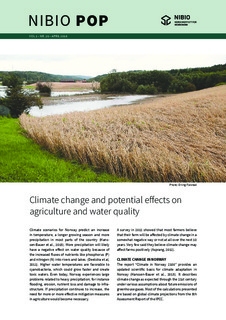| dc.contributor.author | Greipsland, Inga | |
| dc.date.accessioned | 2016-04-27T07:16:05Z | |
| dc.date.accessioned | 2016-04-27T09:06:28Z | |
| dc.date.available | 2016-04-27T07:16:05Z | |
| dc.date.available | 2016-04-27T09:06:28Z | |
| dc.date.issued | 2016-04 | |
| dc.identifier.isbn | 978-82-17-01629-8 | |
| dc.identifier.uri | http://hdl.handle.net/11250/2387555 | |
| dc.description.abstract | Climate scenarios for Norway predict an increase in temperature, a longer growing season and more precipitation in most parts of the country (Hanssen- Bauer et al., 2015). More precipitation will likely have a negative effect on water quality because of the increased fluxes of nutrients like phosphorus (P) and nitrogen (N) into rivers and lakes. (Deelstra et al, 2011). Higher water temperatures are favorable to cyanobacteria, which could grow faster and create toxic waters. Even today, Norway experiences large problems related to heavy precipitation; for instance flooding, erosion, nutrient loss and damage to infrastructure. If precipitation continues to increase, the need for more or more effective mitigation measures in agriculture would become necessary. | |
| dc.language.iso | eng | |
| dc.relation.ispartofseries | NIBIO POP;2(20) 2016 | |
| dc.title | Climate change and potential effects on agriculture and water quality | |
| dc.type | Others | |
| dc.date.updated | 2016-04-27T07:16:05Z | |
| dc.subject.nsi | VDP::Landbruks- og fiskerifag: 900::Landbruksfag: 910 | |
| dc.subject.nsi | VDP::Agriculture and fisheries science: 900::Agricultural sciences: 910 | |
| dc.identifier.cristin | 1484230 | |
| dc.subject.keyword | Jordbruk / Agriculture | |
| dc.subject.keyword | Klimaendringer / Climate change | |
| dc.subject.keyword | Vannkvalitet / Water quality | |
